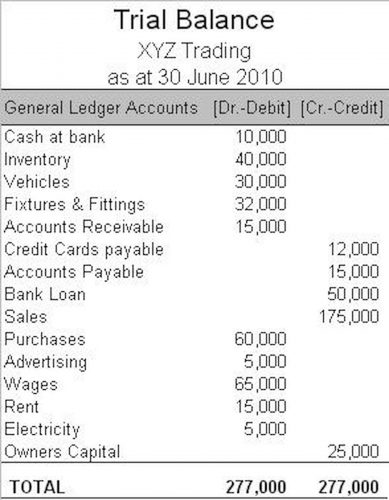
This capability automatically fills in GL or item account lines when a template is applied, making line-item coding a swift, automated process. Streamline invoice coding with easy-to-create templates that auto-populate line items and GL codes. 3-way matching compares the PO, GRN, and vendor invoice to ensure accuracy and consistency, preventing duplicate or fraudulent payments and discrepancies. Some of the details included in the GL coding are the amount, vendor name, invoice category, product line, freight details, country code, business unit, department, and warehouse. Larger business units receive more invoices, and more voluminous will be the GL coding. Generate monthly reports – finance managers need to stay informed on the cash flow and always https://www.bookstime.com/ prepare for audits and information.

Management

Companies simplify the process of identifying tax-deductible expenses and preparing accurate tax filings by using GL codes, meaning they reduce the risk of missed deductions or tax filing errors. Clear tax reporting also enhances compliance with tax laws and regulations, helping businesses avoid costly penalties or legal complications. When expenses are categorized incorrectly, companies may face missed compliance deadlines, misreporting, or costly audit complications. Properly coded expenses lower these risks by ensuring financial data is what is invoice coding consistent, reliable, and compliant with regulatory standards. Accurate GL coding ensures precise financial reporting and reduces errors during month-end close.
- Accounts payable and its management is important for the efficient functioning of your business.
- It is especially important when firms find it challenging to obtain funding via financial or credit institutions.
- The AP team tracks down the PO from purchasing so the invoice can be verified and coded.
- Challenges include excessive paperwork, time delays, matching errors, lack of visibility, exception management, and unauthorized purchases—all of which can hinder efficiency.
- It’s important that everyone recording transactions follows the established GL structure and categories to ensure consistency and accuracy in financial reporting.
- Each GL code corresponds to a specific account in the chart of accounts, such as assets, liabilities, income, or expenses.
- These guidelines will help your business establish consistent procedures, minimize errors, and build a more efficient financial tracking system that delivers reliable data for decision-making.
How to code invoices: The step-by-step process
- As you consider the path forward for your accounts payable process, remember that automation is not just a tool; it’s a catalyst for efficiency, accuracy, and financial success.
- As new departments, cost centers, or projects are introduced, automated systems like Precoro can quickly be updated with new coding rules to accommodate these changes.
- The supplier or vendor will send an invoice to the company that had received the goods and/or services on credit.
- Thus, understanding how these transactions post to a GL account is essential for any entrepreneur looking to stay on top of their company’s finances.
- GL Coding was supposed to save your organization time and money on the reporting side and now that is being edged out by needing additional human capital.
GL codes are used to categorize financial information and to record transactions in the general ledger. Part of the accounts payable invoice processing workload is matching invoice data with related purchase orders and, if applicable, receiving reports (for 2-way or 3-way matching). Three-way matching verifies that goods were ordered in the same quantities at the prices billed by line item on new invoices and that the company is only paying for goods after received. Invoice coding needs to capture the important information related to incoming invoices from suppliers in the accounting and payments system financial records as invoice field data. Automated invoice processing solutions are seamlessly integrated with Enterprise Resource Planning (ERP) systems, fostering real-time data synchronicity. This deep integration eradicates the need for manual data entry, reducing errors and ensuring uniformity of account codes and account numbers across your organisation.

Coding PO-based invoices
- Modern accounts payable workflows are capable of invoice data capture, coding invoices with the right account and cost center, matching invoices and POs, and approving invoices.
- Invoice coding is a critical part of the accounts payable process, and when done incorrectly, it can disrupt financial reporting, delay approvals, and cause audit issues.
- Below, we explore the various steps of the accounts payable workflow, with a focus on invoice coding.
- Federal Sponsored awards require CAS exemptions in order to directly charge certain expenses to sponsored projects that are typically indirect costs.
- Adopting these best practices strengthens your financial operations by enhancing accuracy, consistency, and efficiency.
- General Ledger Codes (GL Codes) are an essential aspect of accounting processes, allowing businesses to categorize their financial information accurately.
The GL code list typically includes a set of codes for each type of financial transaction, such as assets, liabilities, equity, revenue, expenses, and gross vs net taxes. Each code is assigned to a specific account or sub-account within the organization’s chart of accounts. Artsyl’s invoice automation system supports many instruments that make businesses’ lives easier, including GL-Coding and Split Allocations during data entry. Artsyl’s InvoiceAction solution for invoice processing automation takes GL-Coding to the next level with its Enhanced GL-Coding feature. Your ERP system’s GL-Codes will be available to the Verification Station operator in real time, enhancing their work and ensuring that every invoice you receive will be processed correctly. AP automation solutions identify, categorize, and record expenses faster than manual coding.

What is Invoice Coding in Accounts Payable (AP)?
Accounts Payable in SAP operates as a submodule within SAP FI (Financial Accounting), the backbone for recording and overseeing vendor activities. It manages the entire vendor invoicing process, from receipt and validation to approval and payment. All transactions conducted within Accounts Payable are seamlessly integrated with the General Ledger, ensuring financial accuracy. IntelliChief offers a comprehensive solution for automating the general ledger coding of invoices. By leveraging AI-enabled automation, IntelliChief’s platform can robotically capture unstructured data from complex business documents, validate, enrich, and process this data into enterprise-class ERP systems. In addition, as a business grows, managing complex financial data manually becomes increasingly difficult.
Leave a Reply